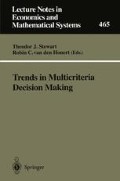Abstract
The paper presents an overview of issues of convergence of interactive procedures in multiobjective optimization and decision support. The issue of convergence itself depends on assumptions concerning the behavior of the decision maker — who, more specifically, is understood as a user of a decision support system. Known procedures with guaranteed convergence under classic assumptions are reviewed. Some effective procedures of accelerated practical convergence but without precise convergence proofs are recalled. An alternative approach to convergence based on an indifference threshold for increases of value functions or on outranking relations is proposed and illustrated by a new procedure called Outranking Trials.
Article Note
The research reported in this paper was partly supported by the grant No. 3P 40301806 of the Committee for Scientific Research of Poland.
Access this chapter
Tax calculation will be finalised at checkout
Purchases are for personal use only
Preview
Unable to display preview. Download preview PDF.
References
Bogetoft, P., Å. Hallefjord and M. Kok (1988) On the convergence of reference point methods in multiobjective-programming. European Journal of Operations Research 34, 56–68.
Brans, J.P. and Ph. Vincke (1985) A preference ranking organization method. Management Science 31, 647–656.
Charnes, A. and W.W. Cooper (1977) Goal programming and multiple objective optimization. J. Oper. Res. Soc. 1 39–54.
Dinkelbach, W. and H. Isermann (1973) On decision making under multiple criteria and under incomplete information. In J.L. Cochrane, M. Zeleny (eds.) Multiple Criteria Decision Making. University of South Carolina Press, Columbia SC.
Ermolev, Yu., and R. J-B. Wets (1988) Numerical Techniques for Stochastic Optimization. Springer Verlag, Berlin-Heidelberg.
Geoffrion, A.M., J.S. Dyer and A. Feinberg (1972) An Interactive Approach for Multicriterion Optimization, with an Application to the Operation of an Academic Department. Management Science 19, 357–368.
Granat, J and A.P. Wierzbicki (1994) Interactive Specification of DSS User Preferences in Terms of Fuzzy Sets. Working Paper of the International Institute for Applied Systems Analysis, WP-94–29, Laxenburg, Austria.
Granat, J., T. Kręglewski, J. Paczyñski and A. Stachurski (1994) IAC-DIDAS-N++ Modular Modeling and Optimization System. Part I: Theoretical Foundations, Part II: Users Guide. Report of the Institute of Automatic Control, Warsaw University of Technology, March 1994, Warsaw, Poland.
Jaszkiewicz, A. and R. Slowiñski (1985) The LBS package — a microcomputer implementation of the Light Beam Search method for multi-objective nonlinear mathematical programming. Working Paper of the International Institute for Applied Systems Analysis, WP-94–07, Laxenburg, Austria.
Kahneman, D. and A. Tversky (1982) The Psychology of Preferences. Scientific American 246 160–173.
Kaliszewski, I. (1994) Quantitative Pareto Analysis by Cone Separation Techniques. Kluwer Academic Publishers, Dordrecht.
Kok, M. and F.A. Lootsma (1985) Pairwise comparison methods in multiple objective programming. European Journal of Operational Research 22, 44–55.
Korhonen, P. and J. Laakso (1985) A Visual Interactive Method for Solving the Multiple Criteria Problem. European Journal of Operational Research 24 277–287.
Lewandowski, A. and A.P. Wierzbicki (1989), eds. Aspiration Based Decision Support Systems. Lecture Notes in Economics and Mathematical Systems 331, Springer- Verlag, Berlin-Heidelberg.
Lootsma, F.A. (1993) Scale sensitivity in multiplicative AHP and SMART. Journal of Multi-Criteria Decision Analysis 2, 87–110.
Lootsma, F.A., T.W. Äthan and P.Y. Papalambros (1985) Controlling the Search for a Compromise Solution in Multi-Objective Optimization. To appear in
Luenberger, D.G. (1973) Introduction to Linear and Nonlinear Programming. Addison-Wesley, Reading, Ma.
Michalevich, M.V. (1986) Stochastic approaches to interactive multicriteria optimizar tion problems. WP-86–10, IIASA, Laxenburg.
Ogryczak, W., K. Studzinski and K. Zorychta (1989) A generalized reference point approach to multiobjective transshipment problem with facility location. In A. Lewandowski and A. Wierzbicki, eds.: Aspiration Based Decision Support Systems Lecture Notes in Economics and Mathematical Systems, 331, Springer-Verlag, Berlin- Heidelberg.
Rios, S. (1994) Decision Theory and Decision Analysis: Trends and Challenges. Kluwer Academic Publishers, Boston-Dordrecht.
Roy, B. and Ph. Vincke (1981) Multicriteria Analysis: Survey and New Directions. European Journal of Operational Research 8, 207–218.
Saaty, T. (1980) The Analytical Hierarchy Process. McGraw-Hill, New York.
Sawaragi, Y., H. Nakayamaand, T. Tanino (1985) Theory of Multiobjective Optimization. Academic Press, New York.
Steuer, R.E. and E.V. Choo (1983) An interactive weighted Tchebycheff procedure for multiple objective programming. Mathematical Programming 26, 326–344.
Steuer, R.E. (1986) Multiple Criteria Optimization: Theory, Computation, and Application. J. Wiley & Sons, New York.
Vincke, Ph. (1992) Multicriteria Decision Aid. J. Wiley, Chichester-New York.
Wierzbicki, A.P. (1980) The use of reference objectives in multiobjective optimization. In G. Fandel, T. Gal (eds.): Multiple Criteria Decision Making; Theory and Applications, Lecture Notes in Economic and Mathematical Systems 177, 468–486, Springer-Verlag, Berlin-Heidelberg.
Wierzbicki, A.P. (1984) Models and Sensitivity of Control Systems. Elsevier-WNT, Amsterdam.
Wierzbicki, A.P. (1986) On the completeness and constructiveness of parametric characterizations to vector optimization problems. OR-Spektrum, 8 73–87.
Wierzbicki, A.P. (1992a) The Role of Intuition and Creativity in Decision Making. WP-92–078, IIASA, Laxenburg.
Wierzbicki, A.P. (1992b) Multiple Criteria Games: Theory and Applications. WP-92–079, IIASA, Laxenburg.
Zeleny, M. (1974) A concept of compromise solutions and the method of the displaced ideal. Comput. Oper. Res. Vol 1, 479–496.
Zeleny, M. (1973) Compromise Programming. In J.L. Cochrane and M. Zeleny (eds.) Multiple Criteria Decision Making. University of Carolina Press, Columbia, SC.
Zionts, S. and J. Wallenius (1976) An Interactive Programming Method for Solving the Multicriteria Problem. Management Science 22 653–663.
Zionts, S. and J. Wallenius (1983) An Interactive Multiple Objective Linear Programming Method for a Class of Underlying Nonlinear Utility Functions. Management Science 29 519–529.
Author information
Authors and Affiliations
Editor information
Editors and Affiliations
Rights and permissions
Copyright information
© 1998 Springer-Verlag Berlin Heidelberg
About this chapter
Cite this chapter
Wierzbicki, A.P. (1998). Convergence of Interactive Procedures of Multiobjective Optimization and Decision Support. In: Stewart, T.J., van den Honert, R.C. (eds) Trends in Multicriteria Decision Making. Lecture Notes in Economics and Mathematical Systems, vol 465. Springer, Berlin, Heidelberg. https://doi.org/10.1007/978-3-642-45772-2_10
Download citation
DOI: https://doi.org/10.1007/978-3-642-45772-2_10
Publisher Name: Springer, Berlin, Heidelberg
Print ISBN: 978-3-540-64741-6
Online ISBN: 978-3-642-45772-2
eBook Packages: Springer Book Archive

